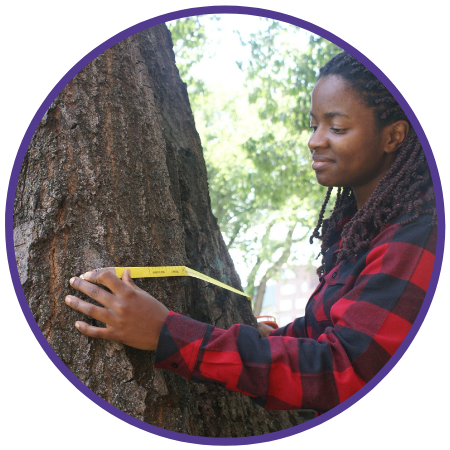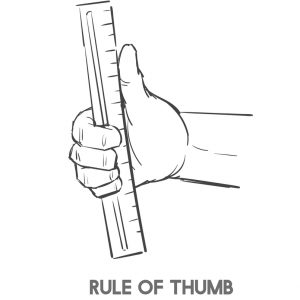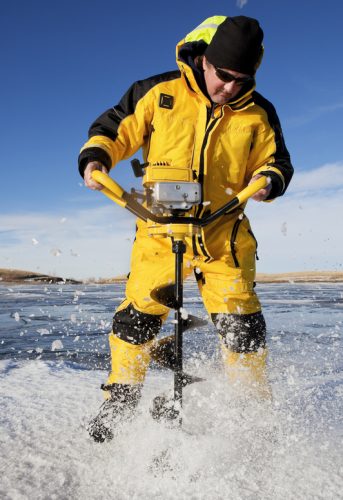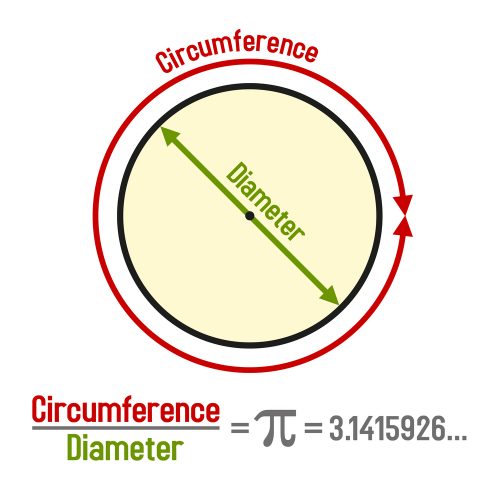Lots of jobs involve the measurement of trees.
Project Learning Tree’s How Big is Your Tree? activity challenges students to use different simple methods to find the height of a tree. With some string and your brain (to do a very simple math equation), you can also find the diameter of a tree.
These enrichments accompany Activity 67, How Big Is Your Tree?, found in Project Learning Tree’s PreK-8 Environmental Education Activity Guide. Be sure to check out the full activity!

Essential Question: What can tree measurements tell us? What might this data communicate about events of the past, present, and future?
Task: Identify a tall tree near your home or school. Use the resources below to estimate tree measurements, including height, diameter (DBH), age, crown spread, and more.
NGSS Connections:
- 5-ESS3-1: Earth and Human Activity – Obtain and combine information about ways individual communities use science ideas to protect the Earth’s resources and environment.
- MS-ETS1-4: Engineering Design – Develop a model to generate data for iterative testing and modification of a proposed object, tool, or process such that an optimal design can be achieved.
- MS-ESS3-5: Earth and Human Activity – Ask questions to clarify evidence of the factors that have caused the rise in global temperatures over the past century.
STEM Strategies

Science
People have not always had rulers or tape measures available when they needed to know the length of something. Instead, people used what they had readily available – including their own body parts – for reference! Did you know that some common phrases still in use today come from a time when body parts were used as a standard measure? For example, “Rule of Thumb” is an expression thought to come from when carpenters used their thumb to estimate length because the average adult thumb is approximately one inch wide.
Similarly, “The Hand” is an ancient unit of length still used today for measuring the height of horses from the ground to the top of the shoulders. The unit was originally defined as the breadth of a human hand, including the thumb, but now standardized at 4 inches (10.16 cm).
Consider this: If your hand is four inches wide, and it is 238,900 miles from the Earth to the moon, how many hands does this equal?
Helpful hints: 3 hands = 1 foot and 5,280 feet = 1 mile

Technology
How did scientists study climate patterns in the past, long before The Weather Channel? Did you know we can learn about climate patterns by collecting and analyzing samples from trees and from ice? It’s true!
An increment borer is a tool used to extract a small tube-shaped sample from a living tree. From this sample, scientists can determine a tree’s age by counting the annual “growth rings”. The study of tree rings, tree age, and associated growth patterns is known as dendrochronology.
For example, these students at Mabelvale Middle School in Arkansas work with an Arkansas Forestry Commission forester to take core samples using an increment borer to age the trees on the property adjoining their school campus.
Ice cores from glaciers and ice sheets can also be collected using a large drill. When the drill bit is pulled up out of the ice, a cylinder of ice is produced. These ice cores can range in size from nearly 20 feet (6 meters) long and 2-4 inches wide. Ice cores are used to measure changes in the climate over long periods of time. Scientists can learn about changes in temperature and precipitation, and even wind patterns and volcanic activity.
Engineering

Wood product engineers develop materials made of wood and oversee their production. They examine materials and conduct measurements associated with ability of engineered wood products to withstand the stresses of construction.
An I-Joist is an engineered wood beam used in many construction projects. This 6-minute video shows Civil Engineering Technology students test I-Joists for their strength at Southern Alberta Institute of Technology in Canada.
Cross Laminated Timber (CLT) is a structural material that can be cheaper, faster, quieter and more sustainable than concrete and steel.
Try making your own laminated wood product. All you need are wooden sticks (such as tongue depressors, popsicle sticks, chop sticks, etc.), wood glue, and rubber bands or binder clips to be used as clamps. Simply apply glue evenly along the surface of one stick and adhere it to another, wrapping it with a clamp to dry overnight. Build and test multiple versions using two, three, and four sticks.
Math
Many people know the value of pi (π) as 3.14, but how many people know where this ratio came from? In truth, the ratio comes from nature. Pi is the ever present and consistent ratio between the circumference of a circle and its diameter, and it has always existed. The earliest textual evidence of π dates back to 1900 BC, as both the Babylonians and the Egyptians had a rough idea of the value.
Did you know that foresters use two tree measurements – height and diameter – to determine the total wood volume of a single tree?
 Try to measure the diameter of your favorite tree! All you need is string (or yarn), scissors, and a ruler (or tape measure).
Try to measure the diameter of your favorite tree! All you need is string (or yarn), scissors, and a ruler (or tape measure).
The first step is to find the circumference. To do this, first measure up 4.5 feet from the base of the tree. This measurement is commonly referred to as “Diameter at Breast Height” or DBH, and it is the height at which foresters measure diameter when conducting a tree inventory.
Have one person hold the end of the string at DBH and then walk around the tree wrapping the string as you go. Be sure to keep the string level so your measurement is as accurate as possible. When you meet up with the other end of string, make a cut. Now you have a piece of sting that is equal to the circumference of the tree at DBH.
Using your piece of string, a measuring tool, and the equations below, try to calculate the diameter of your tree!
If Circumference divided by Diameter = π
Then, Diameter = Circumference divided by π
Additional Resources
Project Learning Tree offers an interactive Find Your Green Job online personality quiz that produces a personalized report with six career recommendations from a total of 36 options, including jobs like forest engineer and wood scientist.
Don’t have PLT’s PreK-8 Environmental Education Activity Guide?
- Purchase a print guide or e-book, available from PLT.org, Amazon and other places where books are sold.
- Get it through your PLT State Coordinator along with hands-on professional development, alignments to state standards and other state-specific supporting resources.
- Watch a YouTube video of Project Learning Tree South Carolina’s Matt Schnabel as he demonstrates the steps and skills to do the How Big Is Your Tree? PLT activity to help students measure trees in different ways and become familiar with a tree’s scale and structure.
Don’t consider yourself a formal teacher?
- Check out a version of PLT’s How Big is Your Tree? activity for families. PLT has over 40 Nature Activities for Families that can be easily used by parents, grandparents, youth group leaders, nature centers, and other nonformal programs.



